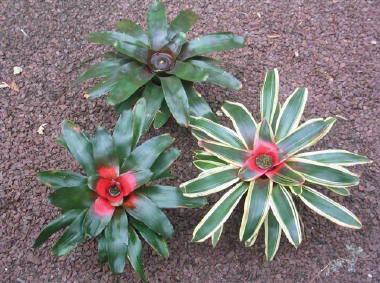|
Summertime Outdoor Exotics
Bobbi Little
Adams County Master Gardener
 Native plants are my preference for outdoor landscaping. They tend to require less maintenance than
non-natives once established, and they provide food and shelter for the local wildlife. However, if you are like many gardeners who enjoy a bit of the unusual, you can add
tropical plants to your deck, porch, or under a tree for an exotic summertime touch. Native plants are my preference for outdoor landscaping. They tend to require less maintenance than
non-natives once established, and they provide food and shelter for the local wildlife. However, if you are like many gardeners who enjoy a bit of the unusual, you can add
tropical plants to your deck, porch, or under a tree for an exotic summertime touch.
Our household is going through the bromeliad phase again, having grown these plants in the past and then giving them away for something
probably weirder. Bromeliads are members of a large family of plants, many of which grow in the tropical rain forests of Central and South America. Most bromeliads are
epiphytes and have long sword-shaped leaves with or without serrations. Other diverse members of this large plant family include the pineapple and Spanish Moss.
Right now I am growing neoregelias, which are a genus in the bromeliad family. They are known for their kaleidoscopic color as you can see in
the photo included with the article. The leaves are patterned with stripes, spots, or speckles and include a multitude of red, pink, or green colors. Their centers contain
cups that catch rainwater in their native tropical rainforests.
|

Bromiliad
|
Neoregelias are easy to grow and like bright filtered light. I’ve grown other bromeliads and tried to harden them to get them accustomed to
sunlight. Don’t try this because you will fry them like I did. They’ll look terrible and then will refuse to die. I have my neoregelias in the woods where they receive
dappled morning sunlight. You can put them under the shade of a bush or tree or in a northern exposure by your house. If they are in pots, you can always pick them up and
create a grouping if you want to decorate for an evening get-together. Let the soil dry out a few days before giving them another good soaking. I keep the cups full of water
outside but am careful because the family dog will readily slurp water out of them and may run the risk of a cut tongue.
Neoregelia leaves are the focal point of this plant, not the flowers. There is no bloom spike, but they produce a flower cluster in the
center cup that is submerged in water. After blooming, the plant will grow a number of new offsets that can be separated when they develop four mature leaves or are about
half the size of the mother plant.
Neoregelias will grow well in most soil mix that is fast draining and pH neutral or slightly acidic. One source recommends using 1 part each
of peat moss, sand or perlite, and chopped decomposed tree bark or pine needles. This is an acidic mix, which is good. It’s easier to just use potting soil developed for use
with orchids. If you check online, you will find other soil mixes for these plants that will work well, too.
If you put any of your houseplants outside for the summer, you’ve probably noticed how they seem to enjoy themselves via growth spurts or
healthier colors. Most of our tropicals move outside for the summer and react as if they’re on vacation. They look healthy. The neoregelias are no exception, giving you great
colorful foliage. Once fall arrives, however, bring them inside. They will thrive by a window but put them in a northern exposure.
If you go to Longwood Gardens, be sure to visit the Conservatory’s tropical rain forest room. You will see many neoregelias there with their
botanical names listed, which is important if you want to find a specific plant. The botanical name, versus the common name, only refers to one plant in the entire universe.
A digital camera is a great way to record what the plant looks like with its nametag on it. The Botanic Gardens in Washington, DC have some wonderful examples, too.
Where can one purchase neoregelias? Check your local garden centers first for the best quality. Skip the chain stores. Garden centers will
always have bromeliads, but not necessarily the neoregelias. I looked everywhere but ended up ordering mine online from vendors that only grow bromeliads. Simply do a search
on ‘neoregelias,’ and you can find many varieties plus how to care for the specific plant. Good luck.
Read other articles on garden and landscape design
Read other summer related gardening articles
Read other
articles by Bobbi Little
|